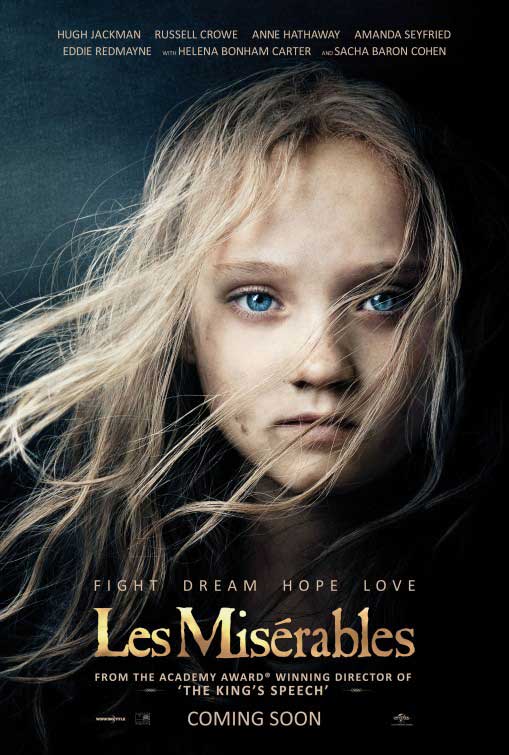
Les Misérables musical personality fits the film and visual display. Anne Hathaway Oscar fixed.
First I should note that I do not like the movie musical. Nor musicals. In any of its forms or styles. And I’m not consumer operas. All this makes Les Miserables has for me more credit than have for any fan of opera, music and musical theater. The reason is that I was hooked almost its entire length despite my little sympathy for this genre. I do not remember this year more intense and devastating interpretation that only Anne Hathaway as Fantine, the end of his descent into hell, in about ten minutes of footage can build an interpretation of Oscar. In my opinion, and with all due respect to the other possible nominees for these awards, the Academy Awards will be very unfair if it does not give the Oscar for letting us emotionally skinned actress with one of the most heartbreaking moments that I remember seeing in film. To remember a cinematic moment that has caused me the same impression and has left me so I have to go back knocked Robert De Niro as Jake La Motta hitting the walls of a cell and shouting: «I am not an animal, I am not an animal Why … they treat me like this? I’m not that bad. » And I should not be the only one, because at the end of the press screening spontaneous applause broke out among the public, which is not usual in this type of session inhabited by critics and journalists.
Alongside the work of Anne Hathaway, another strong point of the film is Hugh Jackman. The player gets to take control of your character and the entire film in record time, from his first appearance, preceded by the visual display of the start of the film epic.
That commitment epic film from the first moment is the third strength of Les Miserables. Tom Hooper took the decision to impose the interpretation of the songs on the set, which is a spectacle in itself so you have to play the unique moment of acting and musical interpretation of the actors replicates the same circumstance that occurs in stages and that feature is one of the most discussed and applauded by the press. But I believe we should also pay attention to the director’s visual approach with his musical version of Les Miserables, which rescues and respects the spirit of great evocative visual that was Victor Hugo, author of the novel that inspired the musical.
Hooper does not resign at any time to impose eminently cinematic visual approach to your movie. Two simple examples, as well as the image of the boat pulled by prisoners with which the film opens. The first is the association of each moment of «death» and «rebirth» of the protagonist, each sequence shows Jean Valjean reinventing himself with images of crosses and cemeteries. Cemetery representing physical death. Crosses representing the character’s idea of transcendence beyond the material that you mark it in your daily sacrifice for others to take it to the end of his life and redemption. This idea of redemption through sacrifice, focus of Les Miserables, is explained visually perfectly with these cutting planes poetic and intimate at the same time spectacular resolution that applies to the path Hooper deaths and resurrections of Jean Valjean .
The second example is the way in which you use the foreground, a tool purely cinematic, non-theatrical, to make the most of the interpretation of Anne Hathaway in Fantine’s solo. Working with light, with the foreground and the actual direction of the actors in this fragment is demolishing simple and beautiful, its beauty lies in the simplicity that results in true. And also claim eminently perfect film of Les Misérables.
Other highlights are also pure cinema, as the presentation of the character of Gavroche, which is also that of Paris, or both Javert solos with the city below. But alongside these, is even more interesting how Hooper decides to pay his debt to the original musical film in the last third of the film, dealing with the rebellion voluntarily theatrical scenery. At the climax, the final knot converging stories all the characters that have been alternating in the role of the story, Tom Hooper paid tribute to his musical recreating a decorated screen theater that involves cutting the protagonists as if to protect them. It’s a risky decision but of remarkable talent and value. Certainly could have persisted in the epic tone and make a purely cinematic display, but choose to work in that key more theatrical set design for the characters that give them privacy in the moment of supreme sacrifice. A brilliant choice.
True, there are other times when, in my opinion, the film becomes more predictable, less interesting, and are related to the love triangle of youth, more topical and predictable because its content is clearly less interesting than the subject of redemption of Jean Valjean and Javert pulse that keeps with, but fortunately even more maudlin moments are a balancing factor and interest in deploying real bright vaudeville worth presenting the history of marriage Thenardier, the other villains of the plot , authentic figures of farce, a parenthesis of Grand Guignol that allows the showcasing of Sacha Baron Coen and Helena Bonham Carter in absurd picaresque key.
Miguel Juan Payán
COMENTA CON TU CUENTA DE FACEBOOK




